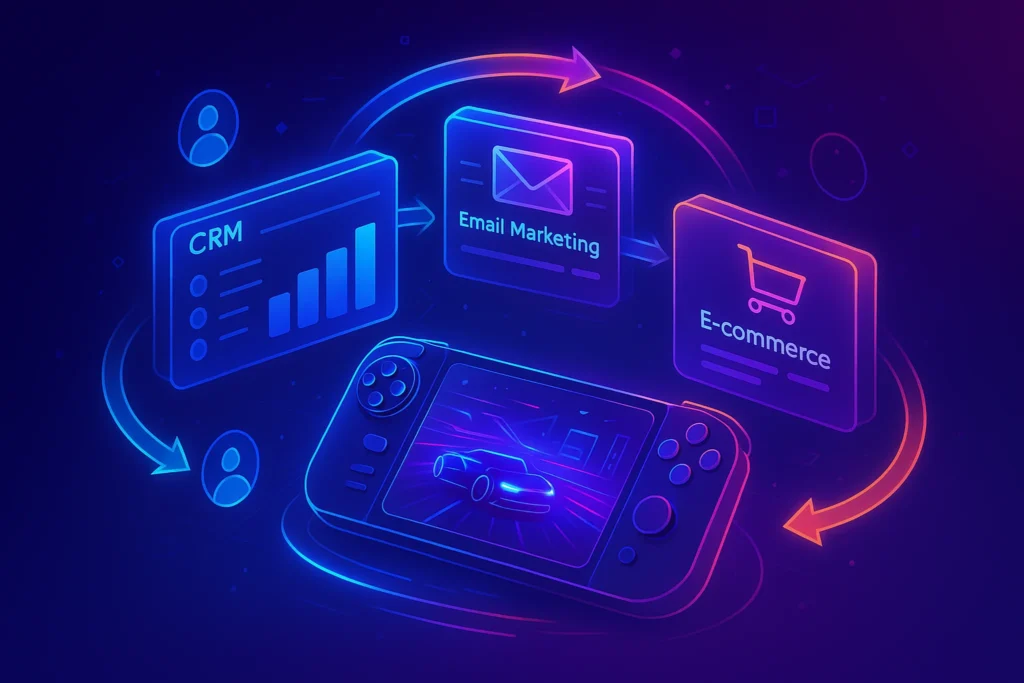🎯 Introduction: Why Contact Syncing Matters More Than Ever
In today’s business landscape, managing contacts is more than just storing email addresses. Small inefficiencies—like exporting CSV files, manually importing them into another system, or dealing with duplicate records—can waste hours every month. These manual processes not only slow teams down but also increase the risk of errors that lead to poor customer experiences. Imagine sending an important campaign only to realize half your list is outdated or filled with duplicates.
This is where automated contact syncing tools come in. They eliminate repetitive manual tasks by keeping your CRM, email marketing platform, and other business tools in sync—instantly and continuously. Whether you’re running a Shopify store and need your customer list updated in Mailchimp, or you’re managing a sales team inside HubSpot, contact sync automation ensures that every contact record is always accurate, complete, and up to date.
Automation in contact management is no longer optional—it’s a competitive necessity. As businesses lean more heavily on personalization and targeted outreach, the quality of your contact data determines the success of your marketing campaigns and sales pipelines. In this guide, we’ll break down the best tools that automatically update and sync your contact lists, how they work, and how you can put them to use without writing a single line of code.
🛠️ The Problem with Manual Contact Management
If you’ve ever dealt with CSV exports and imports, you know the pain: files get outdated quickly, formatting breaks, and errors creep in. Manual contact syncing often creates silos between platforms—your CRM might say one thing while your email marketing platform shows another.
Even worse, outdated contacts can lead to bounced emails, lower deliverability, and wasted ad spend. For growing businesses, this isn’t just an inconvenience—it’s a direct hit on revenue. Automation solves this by creating a two-way sync, where updates in one tool reflect in all connected systems. For example, when a lead updates their email in HubSpot, it automatically reflects in Mailchimp, ActiveCampaign, or wherever else you store contact information.
This also reduces the burden on your team. Instead of spending hours cleaning spreadsheets, they can focus on high-value work like customer engagement and campaign optimization.
👉 If you’ve already automated repetitive workflows like invoice reminders or client onboarding, then syncing contacts is the natural next step. It aligns perfectly with tools you may already use, such as Zapier Alternatives for Budget-Friendly Workflow Automation or CRM-based automations.
🔑 Features to Look for in Contact Sync Tools
Not all syncing tools are created equal. Some only support one-way data pushes, while others provide full two-way sync. The best solutions handle more than just syncing—they clean, deduplicate, and enrich contact records automatically.
When evaluating tools, prioritize:
-
Two-Way Syncing → Updates in one platform should reflect everywhere else.
-
Deduplication → Prevent duplicate contacts from bloating your list.
-
Custom Mapping → Align fields between different platforms (e.g., “First Name” vs “Given Name”).
-
Real-Time Updates → Avoid delays by ensuring changes are synced instantly.
-
Compliance → GDPR/CCPA-ready handling of customer data.
These features aren’t just “nice-to-have.” They determine how reliable your customer data will be when you launch campaigns or run reports.
⚙️ Best Tools for Automatic Contact Syncing
1. PieSync (Now Part of HubSpot Operations Hub)
PieSync was originally a standalone tool designed specifically to sync contact data between apps in real time. It’s now rolled into HubSpot’s Operations Hub, giving small businesses a powerful way to maintain a “single source of truth” for customer data. Instead of exporting and importing CSV files every week, PieSync-style syncing ensures your CRM, email marketing platform, and even Google Contacts stay perfectly aligned.
👉 Who it’s for: Small and medium businesses already using HubSpot, or those wanting enterprise-grade syncing built directly into their CRM.
✅ Pros:
-
True real-time, two-way sync (if you update a phone number in Gmail, it shows in HubSpot instantly).
-
Built-in with HubSpot, reducing the need for multiple subscriptions.
-
Strong focus on compliance and data accuracy.
❌ Cons:
-
Locked into HubSpot’s ecosystem—if you aren’t a HubSpot user, you won’t benefit.
-
Pricing can be steep compared to standalone alternatives.
This tool shines when accuracy and ecosystem integration matter more than budget constraints.
If you’re already using HubSpot, this is the most seamless way to ensure your data stays consistent across platforms. For businesses not on HubSpot, the Ops Hub Starter plan provides an entry point into smart syncing without custom coding.
2. Zapier (and its Alternatives)
Zapier is the “universal connector” in the automation world. Instead of being contact-specific, it allows you to connect 6,000+ apps—from CRMs to email tools to spreadsheets. For example, you can set up a Zap to automatically add new Shopify customers to your Mailchimp list, or sync LinkedIn leads to Google Sheets. Its alternatives like Make (formerly Integromat) or n8n offer similar flexibility, often at a lower cost or with more advanced workflows.
👉 Who it’s for: Businesses that need flexible, cross-app automation without coding knowledge. Perfect for startups juggling multiple platforms.
✅ Pros:
-
Extremely flexible with thousands of integrations.
-
No coding needed—simple for beginners.
-
Strong community and template library.
❌ Cons:
-
Not true two-way sync—many Zaps only push data one way.
-
Can get expensive as you scale tasks.
-
More complex workflows may require technical tweaking.
Zapier is best for breadth and flexibility, but if your sole focus is clean contact syncing, it might feel like overkill.
The downside is that Zapier is more of a one-way sync unless you build more complex workflows. This is where budget-friendly Zapier alternatives shine. We’ve covered those in detail in our guide to Zapier Alternatives for Budget-Friendly Workflow Automation.
3. Insycle
Insycle is less about moving data between apps and more about cleaning and maintaining contact data inside your CRM. It helps with deduplication, standardizing names and addresses, and bulk editing contacts in ways that CRMs don’t always handle gracefully. For businesses dealing with thousands of leads across multiple pipelines, Insycle prevents messy, duplicate-ridden databases that harm marketing and sales productivity.
👉 Who it’s for: Teams already using CRMs like HubSpot, Salesforce, or Pipedrive that struggle with messy, inconsistent data.
✅ Pros:
-
Advanced deduplication and cleansing tools.
-
Works across many major CRMs.
-
Helps ensure high-quality, standardized data.
❌ Cons:
-
Doesn’t replace a sync tool—it focuses on cleanup.
-
Some features require training to use effectively.
-
Extra subscription cost in addition to your CRM.
If PieSync is about syncing, Insycle is about sanity—making sure your contacts are usable once they’re in your system.
Insycle is built for data quality management. Beyond syncing, it focuses heavily on cleaning and deduplication. If you’ve struggled with duplicate contacts across multiple systems, Insycle automatically merges and standardizes data so your lists are clean before syncing.
For businesses scaling fast, Insycle provides peace of mind by ensuring that bad data doesn’t spread across systems—a common issue when syncing is poorly managed.
4. Outfunnel
Outfunnel is an excellent choice for syncing marketing and sales data. It’s designed to bridge CRMs like Pipedrive or HubSpot with email platforms such as Mailchimp. Unlike Zapier, Outfunnel is specialized for revenue teams, making it ideal if your focus is aligning marketing campaigns with sales pipelines.
Outfunnel focuses on bridging marketing and sales by syncing contacts and engagement data between CRMs and marketing tools. For example, when a prospect opens an email, that information can automatically sync back into your CRM so sales teams see the full engagement history. Outfunnel’s edge is in closing the gap between marketing automation and CRM data, so both departments work with the same insights.
👉 Who it’s for: SMBs where sales and marketing teams need to stay aligned without heavy tech stacks.
✅ Pros:
-
Seamless CRM + marketing sync.
-
Tracks engagement (email opens, clicks) at contact level.
-
Simple, clean interface compared to enterprise tools.
❌ Cons:
-
Fewer integrations compared to Zapier.
-
Some advanced analytics are limited.
-
Not ideal if you only need contact syncing without marketing context.
Outfunnel is less of a general-purpose tool and more of a focused solution for marketing-sales alignment.
5. Cleans.io
Cleans.io brings a strong focus on automation-first contact hygiene. It not only syncs but enriches contact records with additional data points from public sources, making your lists more valuable. For businesses trying to personalize outreach at scale, enrichment features give you the edge.
Cleans.io is a newer, lightweight platform designed specifically for automating contact cleanup and syncing. It doesn’t have the enterprise weight of HubSpot or the flexibility of Zapier, but it shines in its simplicity and affordability. Small teams can connect CRMs, email tools, and spreadsheets and keep them clean without hiring an ops manager.
👉 Who it’s for: Startups and small businesses that want a simple, budget-friendly sync tool without a steep learning curve.
✅ Pros:
-
Affordable compared to bigger names.
-
Simple interface that non-techies can use.
-
Focused on syncing and cleanup only (no unnecessary bloat).
❌ Cons:
-
Limited integrations compared to Zapier or HubSpot.
-
Smaller support ecosystem.
-
Still maturing as a product, so may lack enterprise-grade reliability.
Think of Cleans.io as the “lean” alternative—good enough for basic sync and cleaning without overwhelming complexity.
⚡ Takeaway:
-
PieSync/HubSpot = best for businesses already inside HubSpot.
-
Zapier = maximum flexibility, but not pure two-way sync.
-
Insycle = cleanup and deduplication master.
-
Outfunnel = bridges marketing + sales data.
-
Cleans.io = affordable, lightweight solution for small teams.
Data Security & Compliance
When dealing with contact data, security and compliance should never be overlooked. Tools that automatically sync contact lists often handle sensitive information, so businesses must ensure the platform is GDPR- and CCPA-compliant. Established services like PieSync or HubSpot emphasize encryption and privacy standards, while cheaper or lesser-known tools may cut corners. Adding a section on compliance shows readers why choosing a reputable provider isn’t just about features—it’s about protecting their customers’ trust.
🎨 Quick Checklist
✅ 5 Must-Have Features in Contact Sync Tools
-
Real-time two-way syncing
-
Automatic deduplication
-
Field mapping flexibility
-
Strong compliance features
-
Integration with major CRMs and email platforms
Hidden Costs & Scalability
Many sync tools start cheap—$10 or $20 a month—but costs escalate once lists reach 10,000 or 50,000 contacts. This often catches small business owners off guard. By pointing out hidden costs and scalability challenges, the post equips readers to plan for growth and choose tools that won’t break the budget later.
📬 Want More Smart AI & Automation Tips?
Join our free newsletter and get weekly insights on automation tools, no-code workflows, and growth tactics—delivered straight to your inbox.
No fluff. Just value for creators and small teams.
🔐 100% privacy. No spam. Unsubscribe anytime. Value-packed tips from NerdChips.
Mini-Comparison: Sheets vs CRM vs Dedicated Sync Tools
Different teams manage contacts differently. Spreadsheets like Google Sheets are cheap but error-prone. CRMs such as HubSpot offer segmentation and analytics but come with higher costs. Dedicated sync platforms, meanwhile, focus entirely on integration and automation. A short comparison makes the trade-offs clear and helps readers choose the best route for their business.
Real-World Use Cases
Concrete examples bring the tools to life:
-
A Shopify store owner syncing new customer emails directly into Mailchimp campaigns.
-
A freelancer connecting Google Contacts to Zoho CRM to avoid manual entry.
-
A B2B team automatically pushing LinkedIn Lead Gen Form submissions into HubSpot.
These case studies highlight how sync tools translate into time saved and business growth.
Offline-to-Online Syncing
Not all contacts start online. Many businesses still collect leads at trade shows, retail shops, or via pen-and-paper forms. Tools like Google Forms or Zapier integrations allow these offline contacts to flow instantly into CRMs or mailing lists. Including this angle demonstrates the real-world flexibility of sync automation.
📊 Comparison Table
| Tool | Sync Type | Deduplication | Best Use Case | Pricing Model |
|---|---|---|---|---|
| HubSpot Ops Hub | Two-way | Yes | HubSpot CRM users | Tiered plans |
| Zapier | One-way | Limited | General automation | Free + Paid |
| Insycle | Two-way | Strong | Data cleaning + syncing | Subscription |
| Outfunnel | Two-way | Moderate | Sales + Marketing alignment | Subscription |
| Cleans.io | Two-way | Yes + Enrich | Enriched contact management | Subscription |
📐 Practical Example: From Shopify to Mailchimp
Consider a Shopify store owner who wants every new customer to flow into their email marketing tool automatically. Without automation, this means exporting order data weekly and uploading it into Mailchimp—a process prone to errors and delays.
By using tools like Outfunnel or HubSpot Ops Hub, that sync is instant. Every time someone makes a purchase, their contact record is updated in Mailchimp with the right tags for segmentation. This allows for immediate personalized email follow-ups—something that can boost sales dramatically.
For more ideas on streamlining email automation, check out our guides on Email Automation for Shopify Store Owners and Email Automation for Non-Techies.
🧠 Nerd Picks
Thinking of trying contact syncing for your business? Start with HubSpot Ops Hub if you want all-in-one power, or explore Outfunnel for sales + marketing alignment. For cost-conscious teams, Insycle and Cleans.io offer affordable, specialized options.
👉 These tools often come with free trials, so test them in your stack and see immediate results.
Multi-Channel Marketing Integration
Contact syncing isn’t just for email. When integrated properly, synced data flows into SMS marketing, WhatsApp campaigns, and even Facebook Custom Audiences for retargeting ads. Highlighting this shows how automation expands beyond email to create a fully connected marketing ecosystem.
🧠 Nerd Verdict
Automated contact syncing may sound like a small operational upgrade, but it has outsized effects on productivity, customer experience, and revenue growth. Clean, up-to-date contact data is the foundation of successful marketing and sales campaigns. Whether you choose HubSpot’s Ops Hub, Insycle, or Outfunnel, the ROI is clear: fewer manual tasks, more accurate targeting, and smoother workflows across your entire team.
❓ FAQ: Nerds Ask, We Answer
💬 Would You Bite?
If you could eliminate contact list headaches forever with a single tool, would you invest in it today—or keep relying on spreadsheets?



